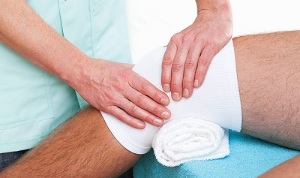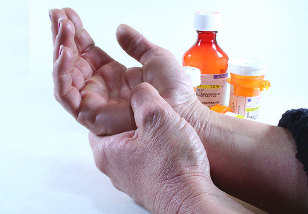The most common joint diseases are arthritis and osteoarthritis. The two diseases have many differences, on which the outcome of the disease largely depends. The correct definition of the disease by a specialist doctor is the key to effective treatment for the complete recovery of the affected joints. Under the influence of age-related changes, every person has a risk of pathological changes in the joints. Particularly affected are the joints, which are subjected to greater stress throughout life. Diseases can be a direct cause of joint changes. To prevent undesirable consequences from diseases of the joints, it is necessary to prevent the development of the disease, adhering to prevention and treatment measures.
The main differences between arthritis and osteoarthritis
Joint disorders: arthritis and osteoarthritis negatively affect the patient's quality of life. The process that causes the disease in the joint causes pain and restriction of movement. Both diseases lead to destructive changes in the joint structure, but differ in the nature of the origin and course of the disease.
Arthritis, when compared with osteoarthritis, is an acute or chronic inflammatory disease of the joints, which can manifest itself with infections or diseases of an autoimmune nature, become a complication after an injury and also manifest itself in the case of allergic reactions.

Single and multiple joints are affected. In addition, the inflammatory process spreads throughout the body, involving internal organs in the process.
Osteoarthritis is a process of modification of the cartilage, which leads to the destruction of the joints up to a complete loss of movement, like arthritis. A pathological process develops in consideration of age-related changes in the tissues of the joint, which are aggravated by the patient's excess weight, metabolic disorders and pathologies of the endocrine system.
The causes of arthritis and osteoarthritis differ significantly. The only unifying factor is the similarity of some symptoms and the deplorable outcome of untreated forms.
Arthritis trigger:
- development of inflammation of the joint tissues of the knee after trauma of various kinds;
- knee joint infection of viral, fungal and bacterial etiology;
- severe allergies;
- prolonged exposure to cold air;
- lack of vitamins and minerals;
- hereditary predisposition.
The onset of osteoarthritis differs from arthritis in the inevitability of changes in every adult. Knowing the etiology of the disease, even at a young age, it is possible to adapt the diet and lifestyle to prevent the pathology.
Development takes place under the following conditions:
- wear of the joint components results from aging;
- the increase in body weight significantly increases the daily load on the knees;
- deforming disorders due to injury;
- malnutrition;
- osteoarthritis can be a complication of arthritis, or rather inflammation, which is present in this disease;
- autoimmune diseases of unexplained etiology;
- congenital diseases associated with the joints;
- violation of trophism and blood supply to the joint;
- malfunction of the thyroid gland;
- changes in hormone levels;
- polluted environment.
Difference Features
These two diseases look similar but differ in many ways. Among the young population, up to forty years old, arthritis is more common and the destructive processes of the cartilage tissue affect the elderly and the older the person, the greater the risk of disease.
Arthrosis is a disease that is mainly localized in the joints, without spreading to the surrounding organs and tissues. Arthritis can be one of the manifestations of a more serious disease involving the entire body in the inflammatory process. Both diseases can manifest themselves in acute and chronic forms, only osteoarthritis develops for a longer time and can lead to complete destruction of the joints.
Arthritis has brighter symptoms, accompanied by characteristic external manifestations of inflammation: hyperemia in the area of localization of the process, pronounced swelling, warm skin in the area of the affected joint, pain syndrome. Osteoarthritis proceeds more smoothly, without spreading beyond the joint.
Arthritis, unlike osteoarthritis, very often involves small joints in the process: hands, feet, wrist and ankle. The disease rarely affects a joint, polyarthritis is a more common form, and osteoarthritis is localized in large joints.
According to statistics, middle-aged men are more likely to develop joint pathologies from infections and viruses. Processes that deform the joints are more common in the female population during menopause, mainly after the age of fifty. Children can also be exposed to joint damage, especially juvenile arthritis is considered dangerous, which can cause limitation.
Signs of manifestation
It is important to consult a doctor at the first symptoms for correct recovery and restoration of the joints for optimal motor activity. Arthritis and osteoarthritis differ significantly in the initial period of the disease. Inflammation manifests itself with the severity of symptoms, for which it is easy not to miss the initial process.
Dystrophic changes in the tissues of the joint are poorly manifested in the initial stage, so patients often come to an orthopedist when the disease is in the second or third stage of development. In this case, the treatment is complicated, time-consuming and requires many steps to restore normal joint function. A slow process is difficult to diagnose on its own, but for any manifestation of discomfort in the joint, you just need to go to the doctor's office in order not to miss the initial stage of the disease.
How does arthritis manifest itself?
- In contrast to osteoarthritis, with arthritis, swelling appears around the inflamed joint, hindering movement and causing a lot of discomfort when moving independently.
- In acute inflammation, the skin of the joint becomes hyperemic and hot to the touch.
- If the arthritis is of the type caused by an infection. The general condition of the patient suffers, intoxication begins, which is accompanied by a feverish condition.
- A stabbing pain appears in the inflamed joints, which tends to increase significantly with movement. In a calm state, the pain syndrome does not subside, but becomes pulsating.
- In most cases, arthritis is accompanied by a general worsening of the condition, weakness appears, and chronic diseases worsen.
- The most vulnerable are the joints of the fingers and toes, as well as the ankle and hand.
Symptoms of osteoarthritis
Manifestations of arthrosis do not have characteristic signs in the early years of the disease, wear of the joint makes itself felt after different stages of the development of the pathological condition.
Signs of osteoarthritis:
- pain does not appear immediately, pain increases with worsening of the condition of the joint;
- in the absence of movement, the pain does not manifest itself, the pain syndrome begins to develop upon activation;
- in case of damage to the hip or knee joint: the gait becomes limp and the range of motion is incomplete;
- in conditions of neglect shortening of the lower limb may occur, in the absence of correction pathologies of the spine develop;
- when cartilage tissue is destroyed, the joint loses mobility and complete blockage of the joint occurs;
- Pronounced crepitus in the joint during physical activity.
How to treat diseases?

Arthritis and osteoarthritis differ significantly in the approach to treatment. Various causes and mechanisms of the development of pathology suggest the initial setting of the correct diagnosis so that therapeutic measures are effective.
In order not to start the disease and waste valuable time, do not rely on the experience of friends and folk recipes.
Pathological processes that have a detrimental effect on the joints should not be allowed to run their course. It is important to experience the joy of movement at any age; not only a person's well-being, but also the quality of life depends on it.
Treats arthritis
Treatment should begin with identifying the factors causing the inflammation. After determining the nature of the origin of the disease, drugs are prescribed that destroy the pathogen of the pathology. When exposed to pathogenic bacteria, the patient is prescribed antibiotics, which, depending on the severity of intoxication, are prescribed in the form of tablets or injections. Viral lesions are treated with antiviral pills.
The basis for effective removal of inflammation and pain suppression will be the mandatory intake of non-steroidal anti-inflammatory drugs. They will help cope with unwanted symptoms, both when taking pills and for local effects on the sore joint area.
Strengthening the immune system is the basis for effective disease control. Taking multivitamins with micronutrients will support a weakened body and help transform the course of the disease towards recovery. In addition to synthetic complexes, natural sources of vitamins are also useful: berries, fruits, vegetables.
Adequate nutrition and a special diet are indicated for patients with arthritis and osteoarthritis. Permitted products include fermented milk products, lean meats, fish, vegetables, herbs. You will have to give up strong coffee and black tea, carbonated and alcoholic drinks.
Physiotherapy exercises and physiotherapy procedures give excellent results in combination with the main therapy: treatment with a pulsed magnetic field, radon baths, electrophoresis and other methods. The list of special exercises is compiled by a physiotherapist, under whose supervision the load is performed.
We treat osteoarthritis
The disease develops slowly and has a fundamentally different treatment, which should be aimed at restoring the cartilage tissue of the joint. The real salvation will be the use of chondroprotectors, which, with prolonged use and following the doctor's instructions, can prevent the progression of destructive changes and restore damaged cells.
Chondroprotectors support tissue nutrition and promote cartilage repair, as well as an increase in joint fluid production, which serves as the sole source of nutrition for joint components.
When pain occurs, NSAIDs are recommended for the symptomatic treatment of pain. A fortified diet, giving up alcohol and smoking leads to an increase in body resistance and an increase in strength to fight for joint health.
Therapeutic gymnastics by various methods increases blood circulation at the injury site, causes the joints to move, increasing trophism. Traditional recipes, tested over the years, are useful as an additional alternative medicine method.
In the later stages of osteoarthritis and arthritis, the only solution is surgical treatment of the joint capsule. The most commonly used method is cartilage transplantation, which can restore mobility to the affected joint.
How to define a disease?
To ascertain exactly what disease develops in the joints, it is necessary to make an appointment with an experienced orthopedist. At the first meeting, the doctor will conduct a visual examination and ask questions of interest that will help form a picture of the disease.
The results of laboratory blood tests will help differentiate arthritis from osteoarthritis; this will require general and biochemical tests. X-ray examination will help to examine the joint in detail from the inside.
In some pathologies the patient is directed to an MRI examination, which will answer the doctor's questions regarding the diagnosis of the pathology. After collecting all the results, a diagnosis will be made, which will serve as the basis for prescribing treatment.
Preventive measures
Keeping your joints healthy requires a healthy lifestyle. Proper nutrition and regular exercise will extend the life of the joints, which is important for overall health.
At the slightest manifestation of osteoarthritis or arthritis, in no case should you be treated alone. Inadequate actions can adversely affect the outcome of the disease. Timely referral to a specialist and further adherence to appointments guarantee successful treatment, which will allow you to lead a healthy lifestyle.






































